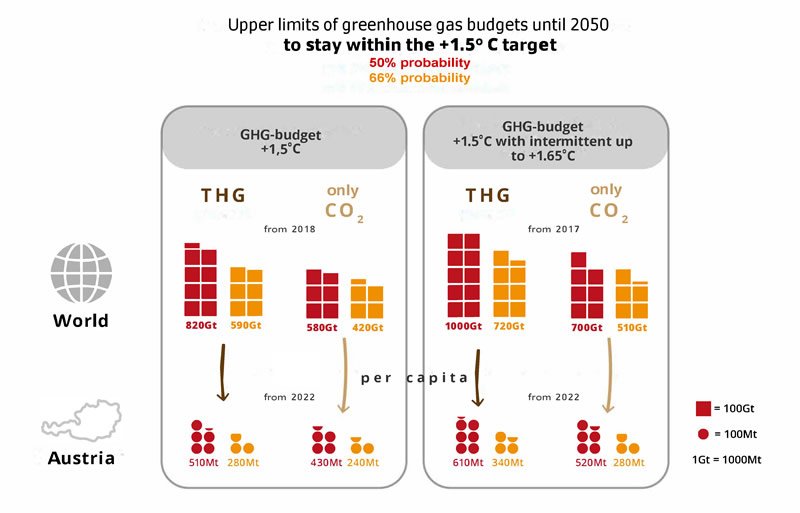A recent paper by the Climate Change Centre Austria (CCCA), a climate research-related alliance of Austrian Universities and other research institutions, provides a scientific basis for climate policies. It underpins the urgency of immediate systematic climate action measures and defines carbon budgets for Austria.
To stay on the +1.5°C/<2°C course, global greenhouse gas (GHG) emissions must be reduced rapidly, as we are currently heading for +2.8°C, which would result in significantly greater losses and damages. A look at the remaining GHG budget – i.e. the amount of GHG that the world may still emit into the atmosphere to meet the +1.5°C/<2°C target – underpins the urgency of immediate systematic climate action measures. A recently published paper by the Austrian climate research network Climate Change Centre Austria (CCCA) analyzes existing scientific literature to explain how global GHG- and CO2-budgets can be scaled down to budgets for Austria. Among other things, the results are to provide a scientific basis for climate policies.

Main findings:
- Analysis of the previous data revealed an almost linear relationship between cumulative anthropogenic CO2 emissions and the temperature increase caused by them. This made calculating CO2 budgets possible.
- The remaining global carbon budget was 420 Gt CO2 in 2018 (66 % probability of not missing the Paris target). With constant emissions, this would be used up within this decade.
- This results in a CO2 budget cap of 240 Mt CO2 for Austria from 2022 or 280 Mt CO2eq including all GHG emissions. Austria's national GHG budget would be exhausted by mid-2025 if emissions remained the same.
- These calculations assume that the existing natural GHG sinks (e.g. forests, peatlands, soil) remain effective at unchanged levels (globally and nationally). However, this requires additional efforts in Austria given current soil sealing, agricultural practices, destruction of forests by pests (e.g. bark beetles) and extreme events (e.g. forest fires).
- The distribution of the GHG budget at federal state level is crucial to enable countries and sectors to plan their GHG reduction measures with certainty. However, this requires further research and calculations, since a determination based solely on production-based emissions accounting and per capita allocation is not significant for this level of detail.
► Full version of paper (in German)
► Fact sheet (in German)







